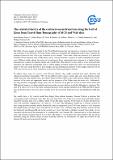Por favor, use este identificador para citar o enlazar a este item:
http://hdl.handle.net/10261/206998COMPARTIR / EXPORTAR:
 SHARE
BASE SHARE
BASE
|
|
| Visualizar otros formatos: MARC | Dublin Core | RDF | ORE | MODS | METS | DIDL | DATACITE | |

| Título: | The crustal structure of the continent-ocean transition along the Gulf of Lions from Travel-Time Tomography of MCS and WAS data |
Autor: | Merino Pérez, Irene CSIC ORCID; Prada, Manel CSIC ORCID ; Ranero, César R. CSIC ORCID; Sallarès, Valentí CSIC ORCID ; Aslanian, D.; Schnurle, Philippe | Fecha de publicación: | abr-2019 | Editor: | European Geosciences Union | Citación: | Geophysical Research Abstracts 21: EGU2019-9467 (2019) | Resumen: | The Gulf of Lions margin is located in the West Mediterranean Sea and opened as a back-arc basin from the end of Eocene to the Miocene. Previous studies of this area modelled and interpreted seismic data to explain the geological processes that lead to the formation of this margin. These works show the presence of a particular continent-ocean transition zone (COT) where crustal velocity structure is atypical. The objective of this study is to use advanced joint refraction and reflection tomography (TTT) tools to obtain higher-resolution models that allow (1) characterizing the nature of the crust along the Gulf of Lions margin, and (2) defining the structure of the margin, especially in the COT zone. We present a new velocity model obtained using a joint TTT of two different active-source seismic data sets: ocean bottom seismic (OBS) data and long-streamer data (MSC data). OBS-derived images show the Vp structure of the crust and uppermost mantle and the geometry of the Moho along the basin axis. Additionally, the long-streamer tomographic image shows the Vp structure of the post-rift section in detail, providing insights into basin-scale processes that occurred after lithospheric extension. The joint TTT allows us to invert the main geological horizons of the margin identified in the OBS and MCS images and, for the first time in this area, also to jointly invert the geological horizons present and identified in both data sets. Our results show a Vp velocity model that display three distinct domains. Domain I shows a structure that corresponds to thin continental crust. Here the crust thins from 15 to 5 km by a system of normal faults. The upper crust has Vp between 5 to 6 km/s and the lower crust with velocities ranging from ~6.0 km/s to ~7.5 km/s. The lithospheric mantle has a velocity around 8.0 km/s along the entire modeled profile. Domain II, which is interpreted as the COT zone, displays a well-delimited lens-shaped body with high crustal velocities (6.0-7.5 km/s). In the central part of the Domain II, where the lens-shaped body is thickest, its top coincides with the top of the basement. The Domain III is characterized by a 4-km thickness crust and velocities ranging from 5.5 to 6 km/s. Based on their markedly different Vp distribution, we argue that Domain II and Domain III might be not genetically linked | Descripción: | European Geosciences Union (EGU) General Assembly, 7-12 April 2019, Vienna, Austria.-- 1 page | Versión del editor: | https://meetingorganizer.copernicus.org/EGU2019/EGU2019-9467.pdf | URI: | http://hdl.handle.net/10261/206998 | Identificadores: | issn: 1607-7962 |
| Aparece en las colecciones: | (ICM) Comunicaciones congresos |
Ficheros en este ítem:
| Fichero | Descripción | Tamaño | Formato | |
|---|---|---|---|---|
| Merino_et_al_2019.pdf | 36,73 kB | Adobe PDF |  Visualizar/Abrir |
CORE Recommender
Este item está licenciado bajo una Licencia Creative Commons

